['Air Programs']
['Greenhouse Gases']
10/09/2025
...
Paragraphs (a) through (f) of this section apply to data used for fuel economy labeling under subpart D of this part. Paragraphs (d) through (f) of this section are used to calculate 5-cycle carbon-related exhaust emission values for the purpose of determining optional credits for CO2-reducing technologies under §86.1866 of this chapter and to calculate 5-cycle CO2 values for the purpose of fuel economy labeling under subpart D of this part.
(a) City fuel economy. For each vehicle tested under §600.010-08(a), (b), or (c), as applicable, determine the 5-cycle city fuel economy using the following equation:
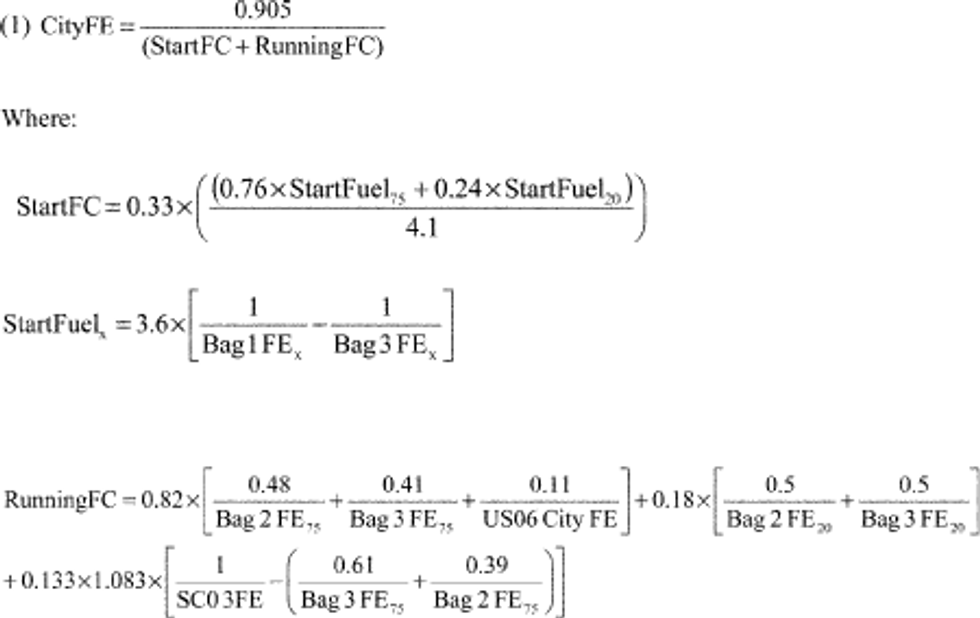
(2) Terms used in the equations in this paragraph (a) are defined as follows:
Bag Y FEX = the fuel economy in miles per gallon of fuel during bag Y of the FTP test conducted at an ambient temperature X of 75°F or 20°F.
SC03 FE = fuel economy in mile per gallon over the SC03 test.
US06 City FE = fuel economy in miles per gallon over the “city” portion of the US06 test.
(b) Highway fuel economy. (1) For each vehicle tested under §600.010-08(a), (b), or (c), as applicable, determine the 5-cycle highway fuel economy using the following equation:
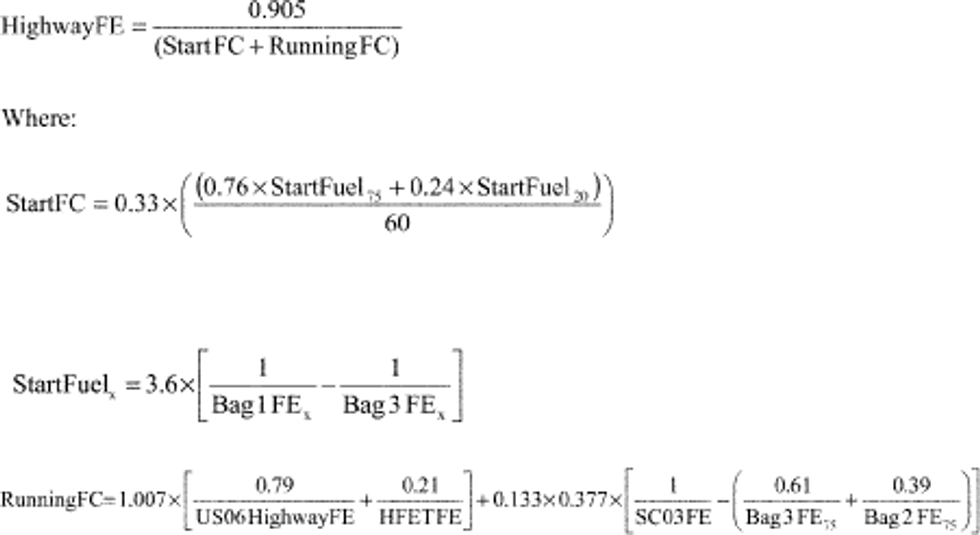
(2) If the condition specified in §600.115-08(b)(2)(iii)(B) is met, in lieu of using the calculation in paragraph (b)(1) of this section, the manufacturer may optionally determine the highway fuel economy using the following modified 5-cycle equation which utilizes data from FTP, HFET, and US06 tests, and applies mathematic adjustments for Cold FTP and SC03 conditions:
(i) Perform a US06 test in addition to the FTP and HFET tests.
(ii) Determine the 5-cycle highway fuel economy according to the following formula:
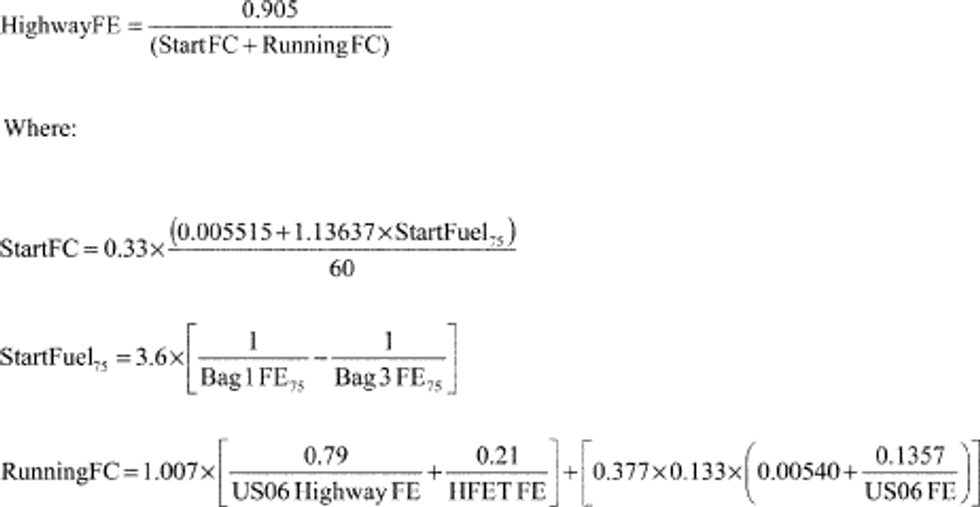
(3) Terms used in the equations in this paragraph (b) are defined as follows:
Bag Y FEX = the fuel economy in miles per gallon of fuel during bag Y of the FTP test conducted at an ambient temperature X of 75°F or 20°F.
HFET FE = fuel economy in miles per gallon over the HFET test.
SC03 FE = fuel economy in mile per gallon over the SC03 test.
US06 Highway FE = fuel economy in miles per gallon over the highway portion of the US06 test.
US06 FE = fuel economy in miles per gallon over US06 test.
(c) Fuel economy calculations for hybrid electric vehicles. Test hybrid electric vehicles as described in SAE J1711 (incorporated by reference in §600.011). For FTP testing, this generally involves emission sampling over four phases (bags) of the UDDS (cold-start, transient, warm-start, transient); however, these four phases may be combined into two phases (phases 1 + 2 and phases 3 + 4). Calculations for these sampling methods follow:
(1) Four-bag FTP equations. If the 4-bag sampling method is used, manufacturers may use the equations in paragraphs (a) and (b) of this section to determine city and highway fuel economy estimates. If this method is chosen, it must be used to determine both city and highway fuel economy. Optionally, the following calculations may be used, provided that they are used to determine both city and highway fuel economy:
(i) City fuel economy.
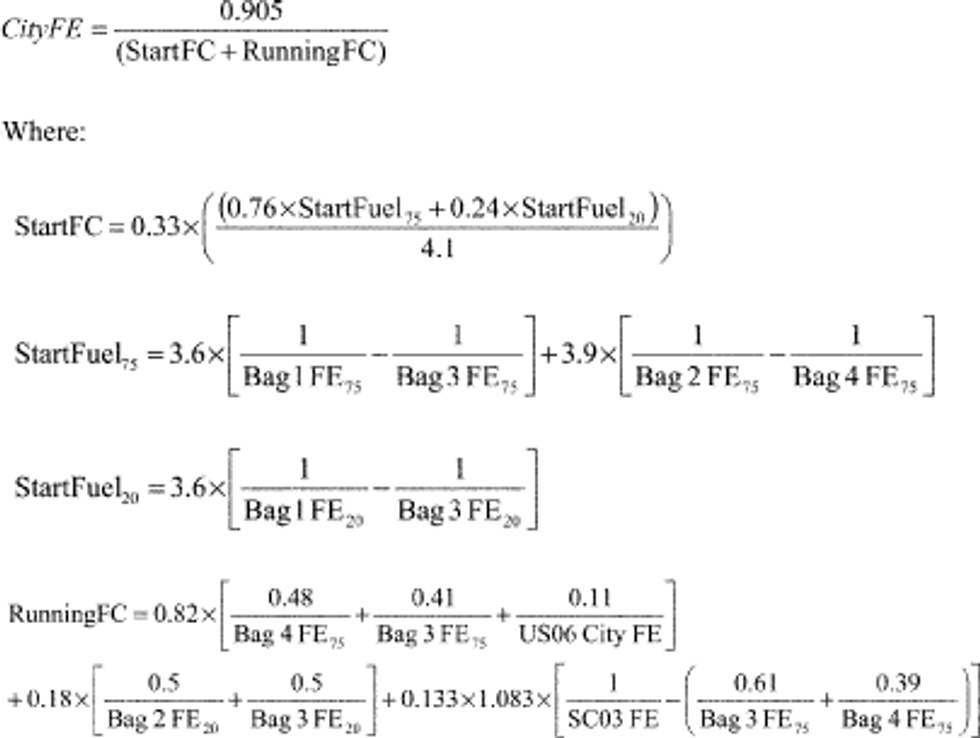
(ii) Highway fuel economy.
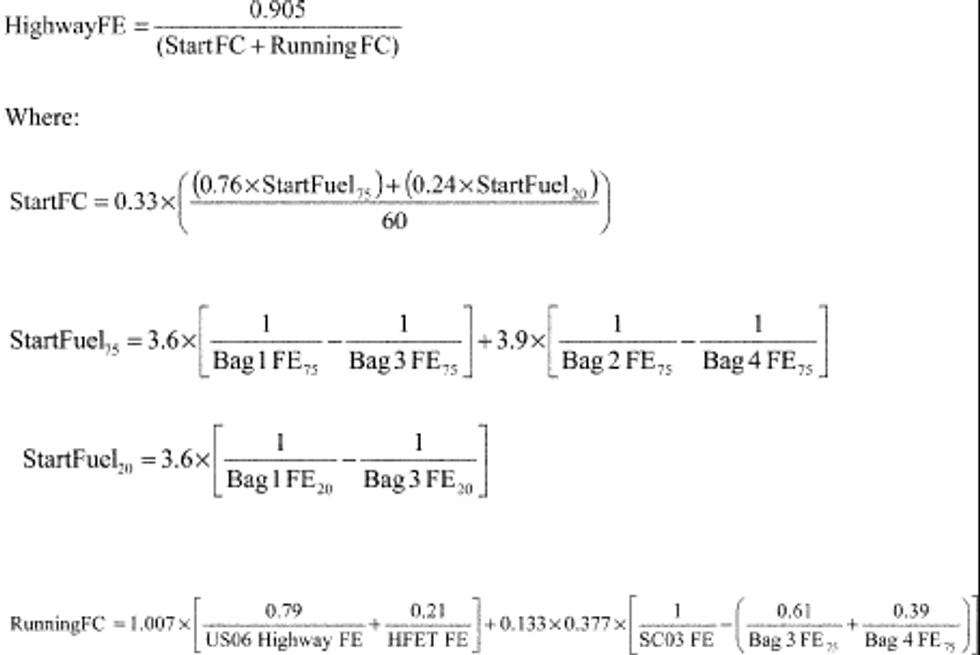
(2) Two-bag FTP equations. If the 2-bag sampling method is used for the 75°F FTP test, it must be used to determine both city and highway fuel economy. The following calculations must be used to determine both city and highway fuel economy:
(i) City fuel economy.
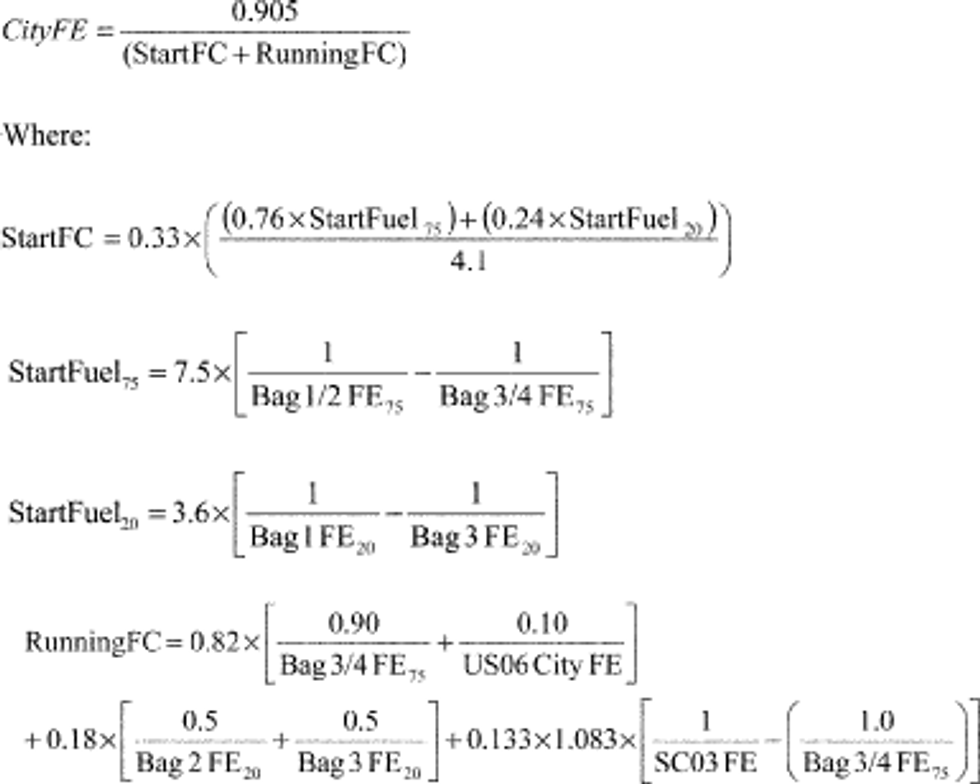
(ii) Highway fuel economy.
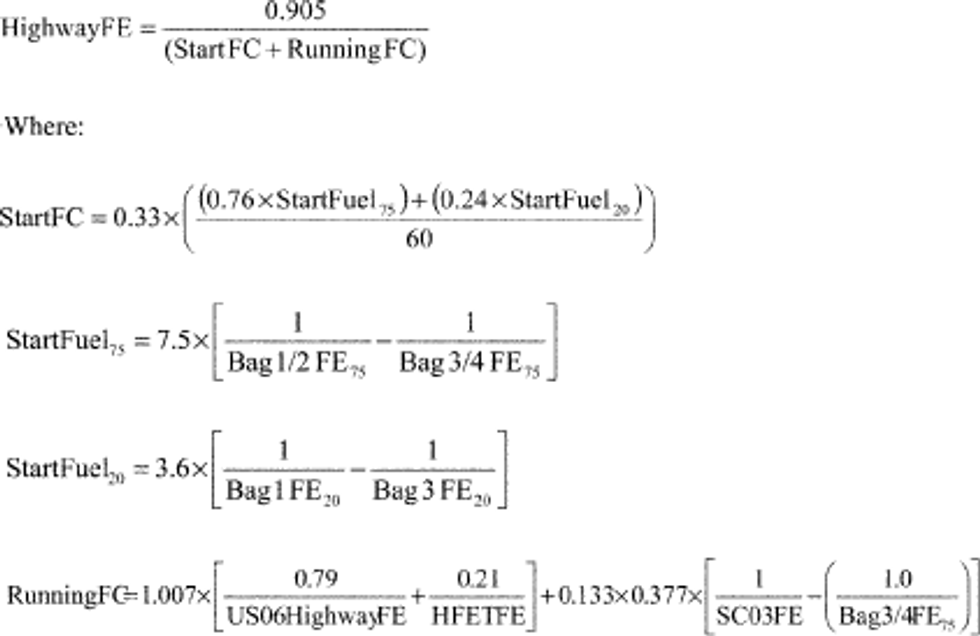
(3) For hybrid electric vehicles using the modified 5-cycle highway calculation in paragraph (b)(2) of this section, the equation in paragraph (b)(2)(ii)(A) of this section applies except that the equation for Start Fuel75 will be replaced with one of the following:
(i) The equation for Start Fuel75 for hybrids tested according to the 4-bag FTP is:

(ii) The equation for Start Fuel75 for hybrids tested according to the 2-bag FTP is:

(4) Terms used in the equations in this paragraph (b) are defined as follows:
Bag X/Y FE75 = fuel economy in miles per gallon of fuel during combined phases X and Y of the FTP test conducted at an ambient temperature of 75°F.
Bag Y FEX = the fuel economy in miles per gallon of fuel during bag Y of the FTP test conducted at an ambient temperature X of 75°F or 20°F.
HFET FE = fuel economy in miles per gallon over the HFET test.
SC03 FE = fuel economy in mile per gallon over the SC03 test.
US06 City FE = fuel economy in miles per gallon over the city portion of the US06 test.
US06 Highway FE = fuel economy in miles per gallon over the highway portion of the US06 test.
(d) City CO 2 emissions and carbon-related exhaust emissions. For each vehicle tested, determine the 5-cycle city CO2 emissions and carbon-related exhaust emissions using the following equation:
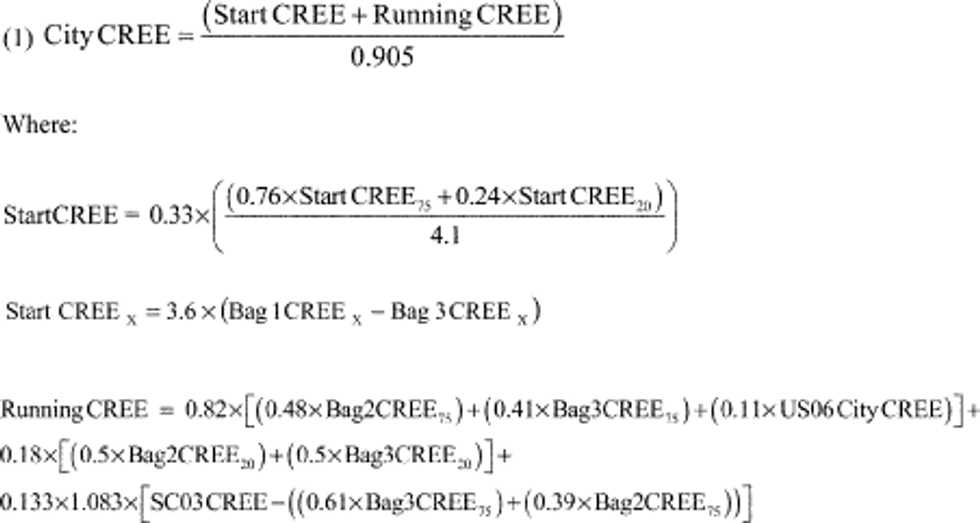
(2) To determine City CO 2 emissions, use the appropriate CO 2 gram/mile values expressed to the nearest 0.1 gram/mile instead of CREE values in the equations in this paragraph (d). The appropriate CO 2 values for fuel economy labels based on testing with E10 test fuel are the measured tailpipe CO 2 emissions for the test cycle multiplied by 1.0166.
(3) Terms used in the equations in this paragraph (d) are defined as follows:
Bag Y CREEX = the carbon-related exhaust emissions in grams per mile during bag Y of the FTP test conducted at an ambient temperature X of 75°F or 20°F.
US06 City CREE = carbon-related exhaust emissions in grams per mile over the city portion of the US06 test.
SC03 CREE = carbon-related exhaust emissions in grams per mile over the SC03 test.
(e) Highway CO 2 emissions and carbon-related exhaust emissions. (1) For each vehicle tested, determine the 5-cycle highway carbon-related exhaust emissions using the following equation:
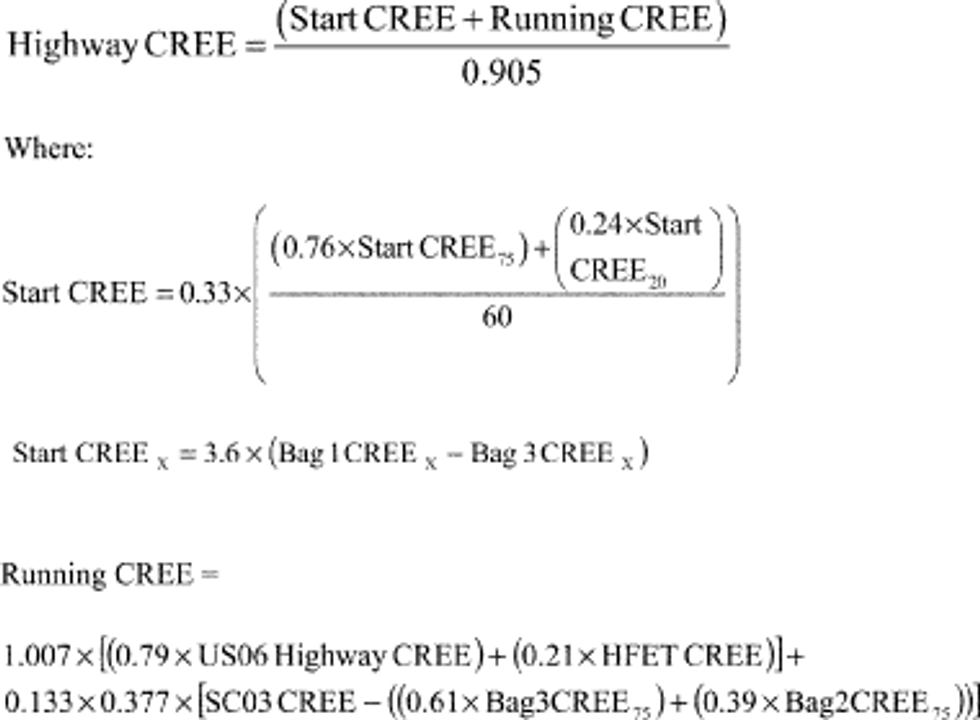
(2) If the condition specified in §600.115-08(b)(2)(iii)(B) is met, in lieu of using the calculation in paragraph (e)(1) of this section, the manufacturer may optionally determine the highway carbon-related exhaust emissions using the following modified 5-cycle equation which utilizes data from FTP, HFET, and US06 tests, and applies mathematic adjustments for Cold FTP and SC03 conditions:
(i) Perform a US06 test in addition to the FTP and HFET tests.
(ii) Determine the 5-cycle highway carbon-related exhaust emissions according to the following formula:

Where:

Start CREE75 = 3.6 × (Bag 1CREE75 − Bag 3CREE75)
Running CREE = 1.007 × [(0.79 × US06 Highway CREE) + (0.21 × HFET CREE)] + [0.377 × 0.133 × ((0.00540 × A) + (0.1357 × US06 CREE))]
(3) To determine Highway CO 2 emissions, use the appropriate CO 2 gram/mile values expressed to the nearest 0.1 gram/mile instead of CREE values in the equations in this paragraph (e) The appropriate CO 2 values for fuel economy labeling based on testing with E10 test fuel are the measured tailpipe CO 2 emissions for the test cycle multiplied by 1.0166.
(4) Terms used in the equations in this paragraph (e) are defined as follows:
A = 8,887 for gasoline-fueled vehicles, 10,180 for diesel-fueled vehicles, or an appropriate value specified by the Administrator for other fuels.
Bag Y CREEX = the carbon-related exhaust emissions in grams per mile during bag Y of the FTP test conducted at an ambient temperature X of 75°F or 20°F.
US06 Highway CREE = carbon-related exhaust emissions in grams per mile over the highway portion of the US06 test.
US06 CREE = carbon-related exhaust emissions in grams per mile over the US06 test.
HFET CREE = carbon-related exhaust emissions in grams per mile over the HFET test.
SC03 CREE = carbon-related exhaust emissions in grams per mile over the SC03 test.
(f) CO 2 and carbon-related exhaust emissions calculations for hybrid electric vehicles. Test hybrid electric vehicles as described in SAE J1711 (incorporated by reference in §600.011). For FTP testing, this generally involves emission sampling over four phases (bags) of the UDDS (cold-start, transient, warm-start, transient); however, these four phases may be combined into two phases (phases 1 + 2 and phases 3 + 4). Calculations for these sampling methods follow:
(1) If the 4-bag sampling method is used, manufacturers may use the equations in paragraphs (a) and (b) of this section to determine city and highway CO 2 and carbon-related exhaust emissions values. The appropriate CO 2 emission input values for fuel economy labeling based on testing with E10 test fuel are the measured tailpipe CO 2 emissions for the test cycle multiplied by 1.0166. If this method is chosen, it must be used to determine both city and highway CO 2 emissions and carbon-related exhaust emissions. Optionally, the following calculations may be used, provided that they are used to determine both city and highway CO 2 and carbon-related exhaust emissions values:
(i) City CO 2 emissions and carbon-related exhaust emissions.
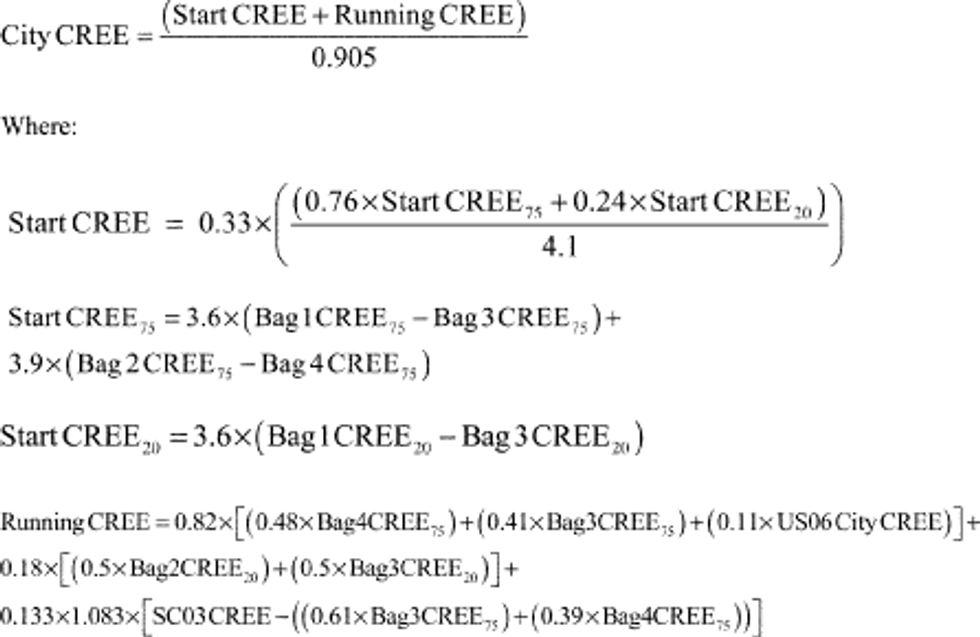
(ii) Highway CO 2 emissions and carbon-related exhaust emissions.
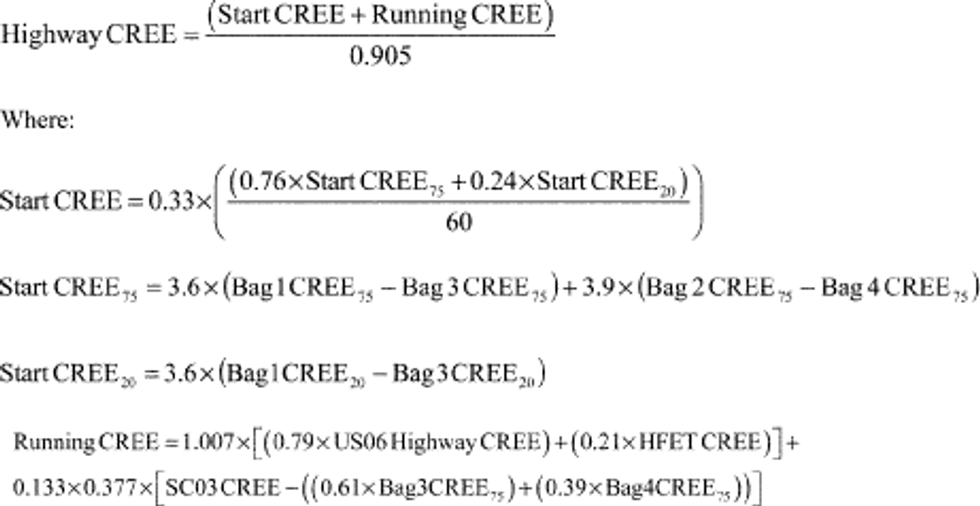
(2) If the 2-bag sampling method is used for the 75 °F FTP test, it must be used to determine both city and highway CO 2 emissions and carbon-related exhaust emissions. The appropriate CO 2 emission input values for fuel economy labeling based on testing with E10 test fuel are the measured tailpipe CO 2 emissions for the test cycle multiplied by 1.0166. The following calculations must be used to determine both city and highway CO 2 emissions and carbon-related exhaust emissions:
(i) City CO 2 emissions and carbon-related exhaust emissions.
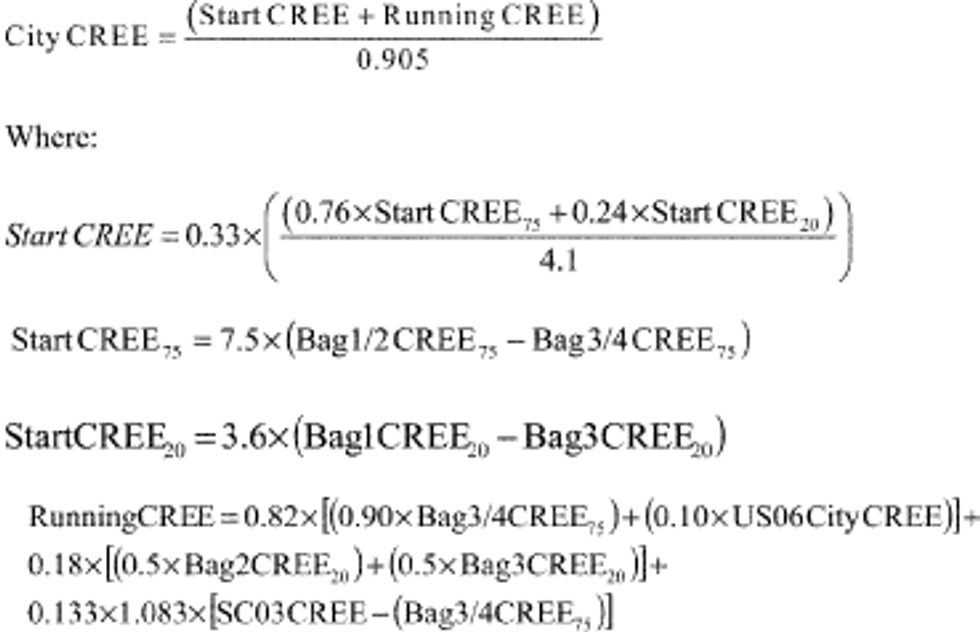
(ii) Highway CO 2 emissions and carbon-related exhaust emissions.
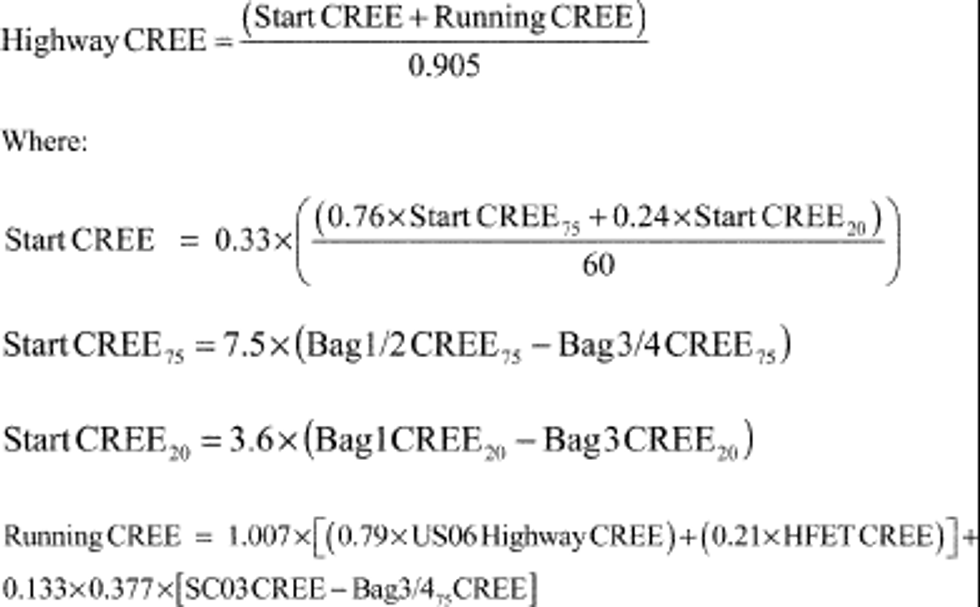
(3) For hybrid electric vehicles using the modified 5-cycle highway calculation in paragraph (e)(2) of this section, the equation in paragraph (e)(2)(ii)(A) of this section applies except that the equation for Start CREE75 will be replaced with one of the following:
(i) The equation for Start CREE75 for hybrids tested according to the 4-bag FTP is:
Start CREE75= 3.6 × (Bag 1 CREE75 − Bag 3 CREE75 + 3.9 × (Bag 2 CREE75 − Bag 4 CREE75)
(ii) The equation for Start CREE75 for hybrids tested according to the 2-bag FTP is:
Start CREE75= 7.5 × (Bag 1/2 CREE75 − Bag 3/4 CREE75)
(4) To determine City and Highway CO 2 emissions, use the appropriate CO 2 gram/mile values expressed to the nearest 0.1 gram/mile instead of CREE values in the equations in paragraphs (f)(1) through (3) of this section.
(5) Terms used in the equations in this paragraph (e) are defined as follows:
Bag Y CREEX = the carbon-related exhaust emissions in grams per mile during bag Y of the FTP test conducted at an ambient temperature X of 75°F or 20°F.US06 City CREE = carbon-related exhaust emissions in grams per mile over the City portion of the US06 test.
SC03 CREE = carbon-related exhaust emissions in grams per mile over the SC03 test.
US06 Highway CREE = carbon-related exhaust emissions in grams per mile over the Highway portion of the US06 test.
HFET CREE = carbon-related exhaust emissions in grams per mile over the HFET test.
Bag X/Y CREE75 = carbon-related exhaust emissions in grams per mile of fuel during combined phases X and Y of the FTP test conducted at an ambient temperature of 75°F.
[76 FR 39538, July 6, 2011, as amended at 76 FR 57379, Sept. 15, 2011; 89 FR 28204, Apr. 18, 2024]
['Air Programs']
['Greenhouse Gases']
UPGRADE TO CONTINUE READING
Load More
J. J. Keller is the trusted source for DOT / Transportation, OSHA / Workplace Safety, Human Resources, Construction Safety and Hazmat / Hazardous Materials regulation compliance products and services. J. J. Keller helps you increase safety awareness, reduce risk, follow best practices, improve safety training, and stay current with changing regulations.
Copyright 2025 J. J. Keller & Associate, Inc. For re-use options please contact copyright@jjkeller.com or call 800-558-5011.
